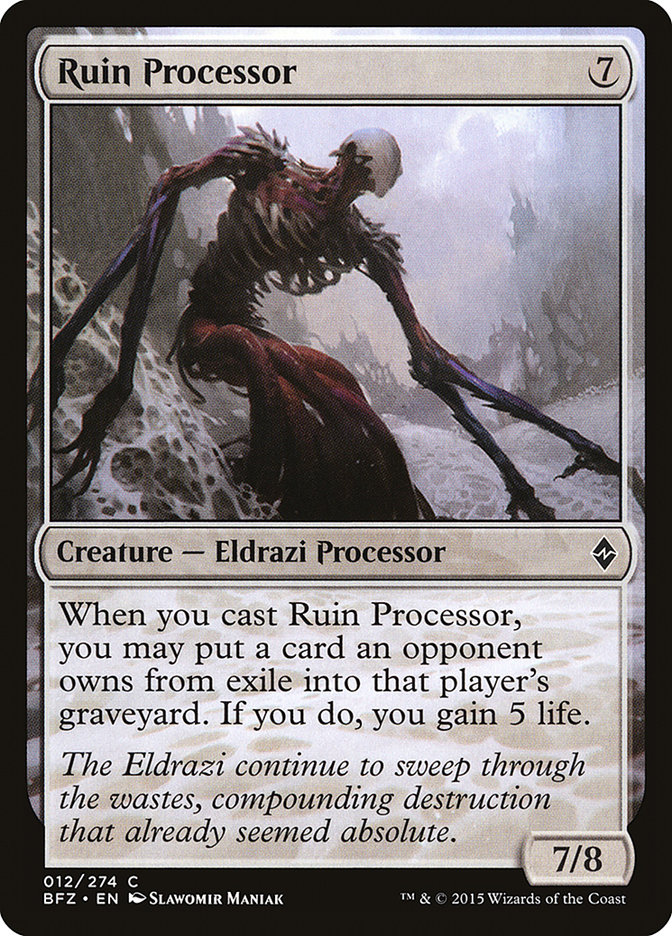Processador da Ruína Carta MTG
| Custo de mana | |
| Custo convertido de mana | 7 |
| Raridade | Comum |
| Tipo | Criatura — Eldrazi Processador |
| Lançamento | 2015-10-02 |
| Expansão símbolo | |
| Expansão nome | Battle for Zendikar |
| Expansão código | BFZ |
| Ataque | 7 |
| Defesa | 8 |
| Número | 12 |
| Frame | 2015 |
| Layout | Normal |
| Border | Preta |
| Ilustrado por | Slawomir Maniak |
Texto da carta
Quando você conjura Processador da Ruína, você pode colocar um card exilado de um oponente no cemitério dele. Se fizer isso, você ganhará 5 pontos de vida.
Os Eldrazi continuam avançando pelos ermos, agravando uma destruição que já parecia absoluta.
Texto da carta Processador da Ruína
Quando você conjura Processador da Ruína, você pode colocar um card exilado de um oponente no cemitério dele. Se fizer isso, você ganhará 5 pontos de vida.
Os Eldrazi continuam avançando pelos ermos, agravando uma destruição que já parecia absoluta.
Onde comprar
Se você deseja comprar um cartão Processador da Ruína MTG de um conjunto específico como Battle for Zendikar, há diversas opções confiáveis a serem consideradas. Uma das principais fontes é a loja de jogos local, onde muitas vezes você pode encontrar boosters, cartas individuais e decks pré-construídos de conjuntos atuais e de alguns conjuntos anteriores. Eles geralmente oferecem o benefício adicional de uma comunidade onde você pode negociar com outros jogadores.
Para um inventário mais amplo, especialmente de conjuntos mais antigos, mercados on-line como TCGPlayer, Card Kingdom e Card Market oferecem seleções extensas e permitem que você pesquise cartas de conjuntos específicos. Grandes plataformas de comércio eletrônico, como eBay e Amazon, também têm listagens de vários vendedores, o que pode ser um bom lugar para procurar produtos lacrados e achados raros.
Além disso, o site oficial do Magic geralmente tem um localizador de lojas e listas de varejistas para encontrar a Wizards of the Produtos licenciados pela Costa. Lembre-se de verificar a autenticidade e a condição dos cartões ao comprar, especialmente de vendedores individuais em mercados maiores.
Abaixo está uma lista de alguns sites de lojas onde você pode comprar os Processador da Ruína e outras cartas MTG:
 COMPRAR
COMPRAR BurnMana é parceiro oficial da TCGPlayer
- eBay
- Card Kingdom
- Card Market
- Star City Games
- CoolStuffInc
- MTG Mint Card
- Hareruya
- Troll and Toad
- ABU Games
- Card Hoarder Magic Online
- MTGO Traders Magic Online
Veja produtos de MTG
Legalidades
Magic the Gathering formats where Processador da Ruína has restrictions
| Formato | Legalidade |
|---|---|
| Commander | Válida |
| Legacy | Válida |
| Paupercommander | Válida |
| Modern | Válida |
| Oathbreaker | Válida |
| Pauper | Válida |
| Vintage | Válida |
| Duel | Válida |
| Pioneer | Válida |
| Penny | Válida |
Regras e informações
O guia de referência para regras de cartas de Magic: The Gathering Processador da Ruína fornece decisões oficiais, quaisquer erratas emitidas, bem como um registro de todas as modificações funcionais que ocorreram.
| Data | Texto |
|---|---|
| 2015-08-25 | Face-down cards in exile are grouped using two criteria: what caused them to be exiled face down and when they were exiled face down. If you want to put a face-down card in exile into its owner’s graveyard, you must first choose one of these groups and then choose a card from within that group at random. For example, say an artifact causes your opponent to exile their hand of three cards face down. Then on a later turn, that artifact causes your opponent to exile another two cards face down. If you use Wasteland Strangler to put one of those cards into their graveyard, you would pick the first or second pile and put a card chosen at random from that pile into the graveyard. |
| 2015-08-25 | If a replacement effect will cause cards that would be put into a graveyard from anywhere to be exiled instead (such as the one created by Anafenza, the Foremost), you can still put an exiled card into its opponent’s graveyard. The card becomes a new object and remains in exile. In this situation, you can’t use a single exiled card if required to put more than one exiled card into the graveyard. Conversely, you could use the same card in this situation if two separate spells or abilities each required you to put a single exiled card into its owner’s graveyard. |
| 2015-08-25 | If a spell or ability requires that you put more than one exiled card into the graveyard, you may choose cards owned by different opponents. Each card chosen will be put into its owner’s graveyard. |
| 2015-08-25 | You can’t look at face-down cards in exile unless an effect allows you to. |
